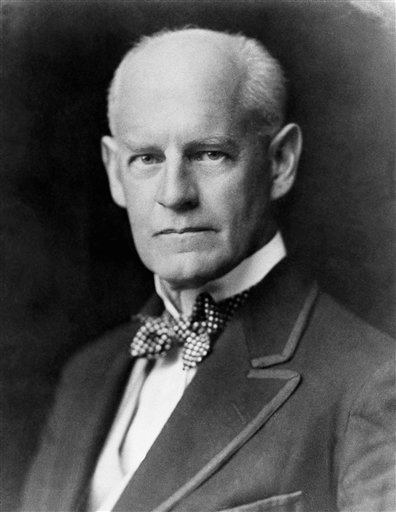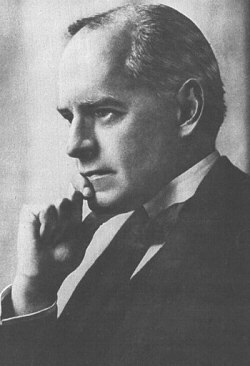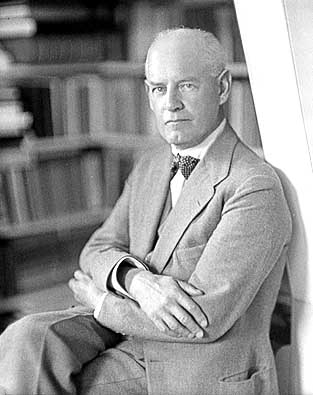<Back to Index>
- Physicist Hans Christian Ørsted, 1777
- Writer John Galsworthy, 1867
- King of Prussia Friedrich Wilhelm I, 1688
PAGE SPONSOR



John Galsworthy OM (14 August 1867 – 31 January 1933) was an English novelist and playwright. Notable works include The Forsyte Saga (1906 — 1921) and its sequels, A Modern Comedy and End of the Chapter. He won the Nobel Prize in Literature in 1932.
John Galsworthy was born at Kingston Hill in Surrey, England, into an established wealthy family, the son of John and Blanche Bailey (née Bartleet) Galsworthy. His large Kingston upon Thames estate is now the site of three schools: Marymount International, Rokeby Preparatory School and Holy Cross. He attended Harrow and New College, Oxford, training as a barrister and was called to the bar in 1890. However, he was not keen to begin practising law and instead travelled abroad to look after the family's shipping business interests.During these travels he met Joseph Conrad, then the first mate of a sailing ship moored in the harbour of Adelaide, Australia, and the two future novelists became close friends. In 1895 Galsworthy began an affair with Ada Nemesis Pearson Cooper (1864 – 1956), the wife of Major Arthur Galsworthy, one of his cousins. After her divorce ten years later, the pair married on the 23 September 1905, and stayed together until his death in 1933. Prior to their marriage they stayed clandestinely in a farmhouse called Wingstone in the village of Manaton on Dartmoor, Devon. From 1908 he took out a long lease on part of the building and made it their regular second home until 1923.
From the Four Winds, a collection of short stories, was Galsworthy's first published work in 1897. These, and several subsequent works, were published under the pen name John Sinjohn and it would not be until The Island Pharisees (1904) that he would begin publishing under his own name, probably owing to the death of his father. His first play, The Silver Box (1906), became a success and he followed it up with The Man of Property (1906), the first in the Forsyte trilogy. Although he continued writing both plays and novels it was as a playwright that he was mainly appreciated for at the time. Along with those of other writers of the time, such as George Bernard Shaw, his plays addressed the class system and social issues, two of the best known being Strife (1909) and The Skin Game (1920).
He is now far better known for his novels and particularly The Forsyte Saga,
his trilogy about the eponymous family and connected lives. These
books, as with many of his other works, dealt with class, and in
particular upper middle class lives. Although sympathetic to his
characters he highlights their insular, snobbish and acquisitive
attitudes and their suffocating moral codes. He is viewed as one of the first writers of the Edwardian era; challenging in his works some of the ideals of society depicted in the preceding literature of Victorian England.
The depiction of a woman in an unhappy marriage furnishes another
recurring theme in his work. The character of Irene in The Forsyte Saga is drawn from Ada Pearson even though her previous marriage was not as miserable as that of Irene. His
work is often less convincing when it deals with the changing face of
wider British society and how it affects people of the lower social
classes. Through his writings he campaigned for a variety of causes
including prison reform, women's rights, animal welfare and the
opposition of censorship. During World War I he worked in a hospital in
France as an orderly after being passed over for military service. He was elected as the first president of the International PEN literary club in 1921, was appointed to the Order of Merit in
1929 — after earlier turning down a knighthood — and was awarded the Nobel
Prize in 1932. He was too ill to attend the Nobel awards ceremony, and
died six weeks later. John Galsworthy lived for the final seven years of his life at Bury in West Sussex. He died from a brain tumour at his London home, Grove Lodge, Hampstead. In accordance with his will he was cremated at Woking with his ashes then being scattered over the South Downs from an aeroplane, but there are also memorials in Highgate 'New' Cemetery and in the cloisters of New College, Oxford (the latter cut and placed in the cloisters by Eric Gill). The popularity of his fiction waned quickly after his death but the hugely successful adaptation of The Forsyte Saga in 1967 renewed interest in his work. A number of John Galsworthy's letters and papers are held at the University of Birmingham Special Collections. In 2007, Kingston University, London opened a new building named in recognition of his local birth. The Forsyte Saga has been filmed several times. The Skin Game was adapted and directed by Alfred Hitchcock in 1931. It starred C.V. France, Helen Haye, Jill Esmond, Edmund Gwenn, John Longden. Escape was filmed in 1930 and 1948. The latter was directed by Joseph L. Mankiewicz, starring Rex Harrison, Peggy Cummins, William Hartnell. The screenplay was by Philip Dunne. One More River (a film version of Galsworthy's Over the River) was filmed by James Whale in 1934. The film starred Frank Lawton, Colin Clive (one of Whale's most frequently used actors), and Diana Wynyard. It also featured Mrs. Patrick Campbell in a rare sound film appearance. The First and the Last, a short play, was adapted as 21 Days, starring Vivien Leigh and Laurence Olivier.